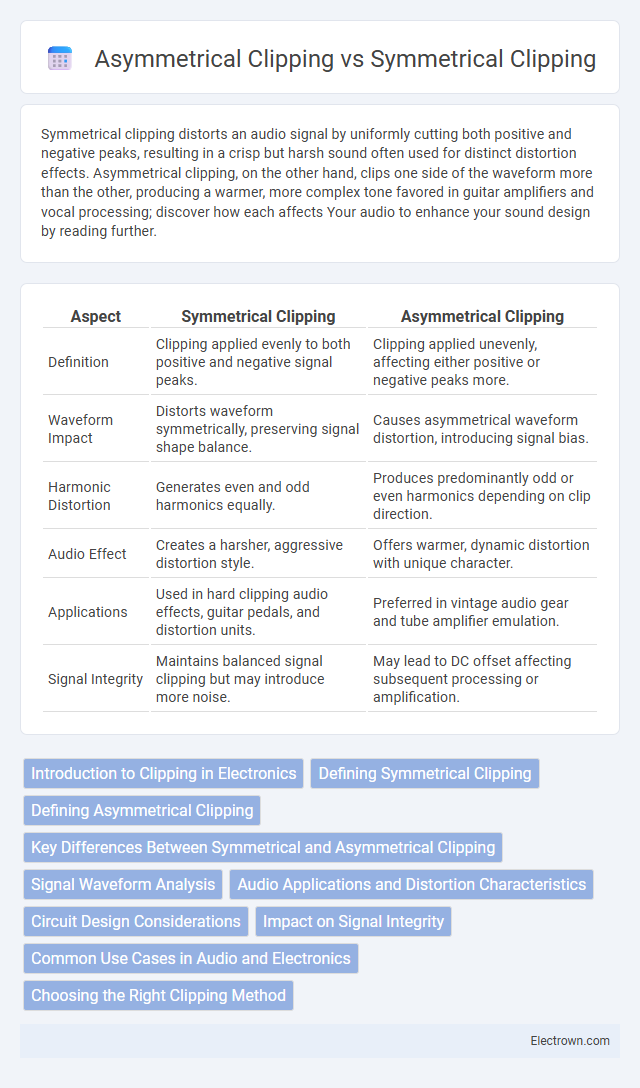Symmetrical clipping distorts an audio signal by uniformly cutting both positive and negative peaks, resulting in a crisp but harsh sound often used for distinct distortion effects. Asymmetrical clipping, on the other hand, clips one side of the waveform more than the other, producing a warmer, more complex tone favored in guitar amplifiers and vocal processing; discover how each affects Your audio to enhance your sound design by reading further.
Table of Comparison
| Aspect | Symmetrical Clipping | Asymmetrical Clipping |
|---|---|---|
| Definition | Clipping applied evenly to both positive and negative signal peaks. | Clipping applied unevenly, affecting either positive or negative peaks more. |
| Waveform Impact | Distorts waveform symmetrically, preserving signal shape balance. | Causes asymmetrical waveform distortion, introducing signal bias. |
| Harmonic Distortion | Generates even and odd harmonics equally. | Produces predominantly odd or even harmonics depending on clip direction. |
| Audio Effect | Creates a harsher, aggressive distortion style. | Offers warmer, dynamic distortion with unique character. |
| Applications | Used in hard clipping audio effects, guitar pedals, and distortion units. | Preferred in vintage audio gear and tube amplifier emulation. |
| Signal Integrity | Maintains balanced signal clipping but may introduce more noise. | May lead to DC offset affecting subsequent processing or amplification. |
Introduction to Clipping in Electronics
Clipping in electronics occurs when an amplifier is overdriven and the output signal is limited, causing distortion. Symmetrical clipping affects both positive and negative halves of the waveform equally, while asymmetrical clipping distorts only one half of the signal. Understanding these differences helps you control harmonic content and shape the tone of audio signals effectively.
Defining Symmetrical Clipping
Symmetrical clipping occurs when an audio signal is clipped evenly at both positive and negative peaks, producing harmonic distortion that is balanced and often perceived as smoother or more musical. This type of clipping maintains waveform symmetry, which helps preserve the original tonal characteristics of the sound. Your audio will exhibit a consistent distortion pattern, making symmetrical clipping preferred in scenarios where signal integrity and tonal balance are important.
Defining Asymmetrical Clipping
Asymmetrical clipping occurs when only one half of an audio waveform is clipped, typically either the positive or negative peaks, resulting in distortion that introduces even-order harmonics and a warmer sound character. In contrast to symmetrical clipping, which truncates both halves of the waveform equally and produces harsher odd-order harmonics, asymmetrical clipping preserves more of the original signal's dynamics. This type of clipping is often used in musical distortion effects to create a more pleasing and musically rich tone.
Key Differences Between Symmetrical and Asymmetrical Clipping
Symmetrical clipping evenly distorts both the positive and negative peaks of an audio waveform, resulting in a balanced but harsher sound, while asymmetrical clipping only distorts one side, often producing a warmer, more musical tone. The key differences include the waveform shape alterations and harmonic distortion levels, with symmetrical clipping generating even-order harmonics and asymmetrical creating odd-order harmonics. Your choice between symmetrical and asymmetrical clipping depends on the desired tonal characteristic and the specific audio processing context.
Signal Waveform Analysis
Symmetrical clipping occurs when both the positive and negative peaks of a signal waveform are clipped equally, resulting in a waveform that maintains its balanced distortion characteristics. Asymmetrical clipping, on the other hand, affects only one polarity, either positive or negative, causing an uneven waveform distortion that can introduce more harmonic distortion and DC offset. Understanding the difference helps you analyze signal waveforms more precisely, optimizing audio processing and amplifier performance.
Audio Applications and Distortion Characteristics
Symmetrical clipping in audio applications produces even-order harmonics that result in a smoother, more musical distortion often used in electric guitar pedals to create warm overdrive effects. Asymmetrical clipping generates odd-order harmonics, leading to a harsher, more aggressive sound favored in distortion pedals for heavier rock and metal tones. The choice between symmetrical and asymmetrical clipping directly affects the tonal character and harmonic content of audio signals, influencing the perception of warmth, brightness, and overall distortion quality.
Circuit Design Considerations
Symmetrical clipping circuits require balanced clipping diodes or transistors on both the positive and negative halves of the waveform, ensuring equal distortion and preserving signal symmetry. Asymmetrical clipping involves unbalanced components, leading to different clipping thresholds on each half-cycle, which affects harmonic content and perceived sound character. Designers must consider power efficiency, component matching, and the desired audio effect when selecting a clipping topology for distortion pedals or signal limiters.
Impact on Signal Integrity
Symmetrical clipping maintains signal integrity by evenly truncating both positive and negative peaks of a waveform, minimizing harmonic distortion and preserving waveform symmetry. Asymmetrical clipping distorts the signal unevenly, introducing significant harmonic content and asymmetry that degrade signal quality and increase error rates. In communication systems, symmetrical clipping is preferred for maintaining signal fidelity, while asymmetrical clipping often results in greater signal degradation and reduced performance.
Common Use Cases in Audio and Electronics
Symmetrical clipping is commonly used in guitar effects pedals and audio distortion circuits to produce a balanced, harmonically rich sound by clipping both positive and negative signal peaks equally. Asymmetrical clipping finds applications in audio compressors and radio transmitters where it intentionally clips one polarity more than the other, creating a warmer distortion or reducing signal distortion in complex waveforms. Both techniques are essential in shaping audio signals and managing power levels in various electronics and communication systems.
Choosing the Right Clipping Method
Choosing the right clipping method depends on the desired sound texture and distortion characteristics in audio processing. Symmetrical clipping produces even distortion with balanced harmonic content, ideal for a clean, consistent overdrive effect, while asymmetrical clipping introduces uneven waveform distortion, generating richer, more complex harmonics favored in blues and vintage tones. Understanding how each clipping method affects the signal's harmonic structure enables engineers to tailor distortion aesthetics for genres, ensuring optimal tonal quality and listener experience.
Symmetrical clipping vs asymmetrical clipping Infographic

 electrown.com
electrown.com